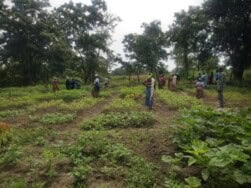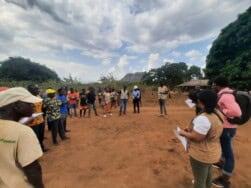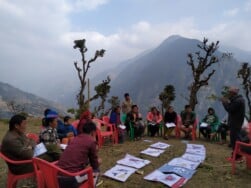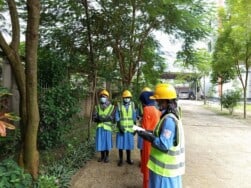Progress toward Climate Resilience through Community-led Environmental Solutions
November 14th, 2024 | Blogs
Communities worldwide are creating solutions to adapt to and mitigate climate change, environmental degradation, and biodiversity loss. They know firsthand how this triple planetary crisis affects their lives and livelihoods, as well as the resources and support they need to build resilience and take action. Centering their perspectives and ensuring community leadership is crucial when designing mitigation strategies, as is directing resources to scale up the most effective methods.
Despite this, from 2003 to 2016 less than ten percent of global climate funds reached local groups. Indigenous communities care for 80 percent of the world’s remaining biodiversity, yet less than one percent of development aid reached Indigenous land management.
There has been some progress in ensuring Indigenous communities are included in conservation efforts. At COP 16, the 16th meeting of the Conference of the Parties (COP) to the Convention on Biological Diversity, participating countries agreed to create a formal subsidiary body for Indigenous peoples and local communities to ensure their involvement in conservation efforts. COP 29 is primarily focused on climate financing, specifically how to channel resources to the countries and communities that most urgently need it. The Greening Education Partnership, of which World Education is a member, will advocate for the critical role of education in global climate action discussions.
We are working with funders, partners, and communities to prioritize community-based solutions like these:
Mothers’ associations in northern Benin–crucial school-based groups ensuring women lead community governance in education–are taking action to address poverty and biodiversity loss simultaneously. Through citizen science, mothers’ associations and their communities gather data on their local ecosystems and use them to design agricultural plots using agroforestry principles. Combining trees and crops into agricultural systems helps restore biodiversity while increasing agricultural productivity, which generates income for schools and communities.
 We’re working with the Government of Benin to institutionalize these community-led, biodiversity-sustaining agroforestry practices by building capacity and improving coordination at all levels. These efforts support Benin’s Nationally Determined Contributions and National Biodiversity Strategy and Action Plans; complement the government’s Communal Forest Management Support Project; and meet key global biodiversity and climate change adaptation objectives.
We’re working with the Government of Benin to institutionalize these community-led, biodiversity-sustaining agroforestry practices by building capacity and improving coordination at all levels. These efforts support Benin’s Nationally Determined Contributions and National Biodiversity Strategy and Action Plans; complement the government’s Communal Forest Management Support Project; and meet key global biodiversity and climate change adaptation objectives.
Communities are also leading the way in Mozambique, where funding for climate resilience interventions is distributed through Community Demand Driven Funds. Communities prioritize what they need to create sustainable living conditions and economic opportunities, and we distribute grants to these projects. With the Government of Mozambique, we are focusing on those––who rely on natural resources for their livelihoods and living conditions, particularly internally displaced persons, women, and youth
 Through these community-led grants, we are strengthening human and social capital and increasing inclusion in decision-making processes around natural resource management to reinforce livelihoods. We also work alongside natural resource management experts at the national level and provide technical assistance to communities throughout project implementation.
Through these community-led grants, we are strengthening human and social capital and increasing inclusion in decision-making processes around natural resource management to reinforce livelihoods. We also work alongside natural resource management experts at the national level and provide technical assistance to communities throughout project implementation.
The impacts of climate change and labor exploitation vary widely by context, making locally-led and -informed interventions essential to address the priorities of affected populations and reflect a country’s diversity. In Nepal, the experiences of children, women, indigenous populations are shaping climate change mitigation and child labor prevention efforts.
 To expand the evidence base on the intersection between climate change and labor exploitation, we’re connecting with communities and listening to their stories. For example, flash flooding–brought on by rising temperatures, glacial melt, and significant rainfall–swept away the home and land of a ten-year-old boy’s family. As a result, he left school to support his family, mining sand on the riverbed for 200 rupees (~$1.50) per day. This is one of many ways families’ livelihoods are becoming more precarious. In addition to this participatory research, we’re supporting community-led solutions that build climate resilience and reduce child labor.
To expand the evidence base on the intersection between climate change and labor exploitation, we’re connecting with communities and listening to their stories. For example, flash flooding–brought on by rising temperatures, glacial melt, and significant rainfall–swept away the home and land of a ten-year-old boy’s family. As a result, he left school to support his family, mining sand on the riverbed for 200 rupees (~$1.50) per day. This is one of many ways families’ livelihoods are becoming more precarious. In addition to this participatory research, we’re supporting community-led solutions that build climate resilience and reduce child labor.
The climate crisis has a unique impact on urban areas. In five cities in Asia, we’re partnering with city residents and governments to create more resilient and livable environments. Schools can be an ideal entry point for resilience activities: teachers and students can build their skills to respond to crises and become champions in their communities.

We are partnering with students, teachers, and city education departments to design and implement a Resilient Schools model. Using elements of the new UNESCO Green Schools Quality Standards and global green school schemes such as Eco Schools, the model takes a student-led, whole-institution approach. Students will form Resilient School Committees to identify environmental issues in their school and communities and develop action plans to address them. Teachers are also integrating a variety of resilience and climate themes into curricula, from energy efficiency to water conservation.
Centering community voices and supporting community-led action are essential to confronting the climate and environmental crisis. By investing in education, we can cultivate informed and skilled citizens ready to respond to these urgent challenges.
World Education fosters enduring partnerships across regions and sectors to advance education outcomes for all. We offer education systems strengthening, program design and implementation, applied research and evaluation, capacity development, and policy development services.